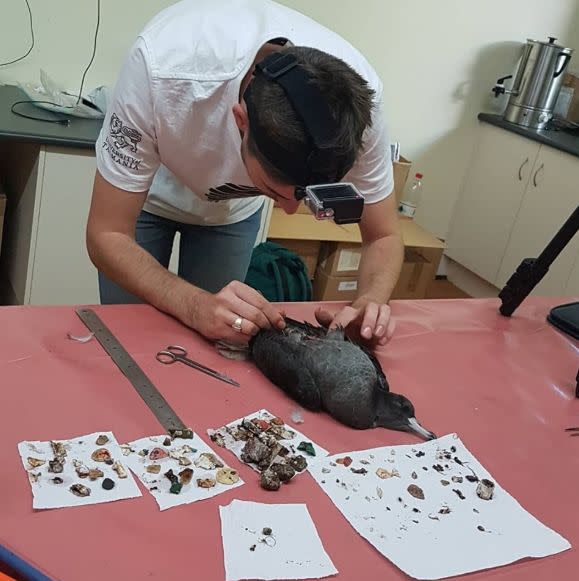The disturbing story behind this seemingly innocent image
At first glance, it appears to be an innocuous photo of dozens of pieces of plastic neatly aligned on a tray.
However the eye-catching picture in fact reveals the shocking dangers plastic waste poses to marine life.
Researcher Peter Puskic shared the photo of 128 minuscule pieces of plastic from his workstation on Lord Howe Island, some 600km east off Australia’s east coast.
Accompanying the image was another photo of himself removing the plastics from a dead seabird, just three months old.
“128 pieces of plastic in a 90 day old Flesh-footed Shearwater chick. Does anything look familiar?” he asked on Facebook.

Mr Puskic works as part of a group of researchers at Adrift Lab whose research is contributing to efforts to reduce marine plastic pollution and in turn save the lives of millions of seabirds.
The World Wide Fund for Nature estimates that one million seabirds are dying every year from either ingesting plastic or becoming entangled in it.
The seabirds on Lord Howe Island are unable to distinguish plastics found in the ocean from their natural food source. In turn the birds are feeding the plastics to their offspring with devastating consequences.
“There are worse places to work but there's nothing worse than pulling plastic out of seabird chicks,” Mr Puskic said online.

Lead researcher at Adrift Lab, Dr Jennifer Lavers, has previously said most of the 300 million tonnes of plastic produced worldwide each year is not recycled, with millions of tonnes ending up in oceans.
“Plastic debris is an entanglement and ingestion hazard for many species, creates a physical barrier on beaches to animals such as sea turtles, and lowers the diversity of shoreline invertebrates,” she said.
“Research has shown that more than 200 species are known to be at risk from eating plastic, and 55 per cent of the world’s seabirds, including two species found on Henderson Island, are at risk from marine debris.”
Dr Lavers previously told the BBC that almost all the cases when plastics are pulled from birds on the island are “entirely preventable”.
The World Wide Fund for Nature says that research indicates by 2050, 99 per cent of all sea birds will have ingested plastic.
Seabirds aren’t the only ones suffering from plastic waste on the island.
Burst balloons are washing up on the island, despite the items only being sold 600km away on the Australian mainland.
Turtles are mistaking the balloons for jellyfish and eating them, often resulting in a slow and painful death as it becomes lodged in their stomachs.
Do you have a story tip? Email: newsroomau@yahoonews.com.
You can also follow us on Facebook, download the Yahoo News app from iTunes or Google Play and stay up to date with the latest news with Yahoo’s daily newsletter. Sign up here.


